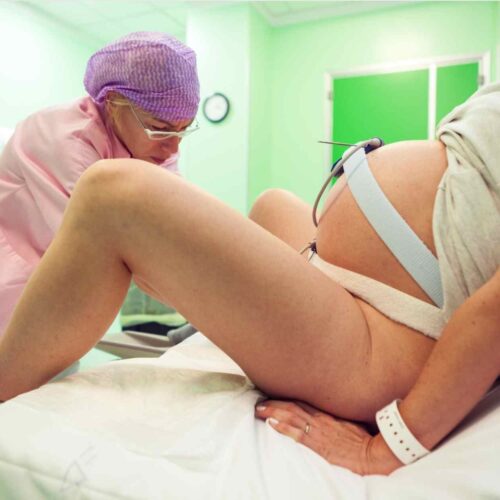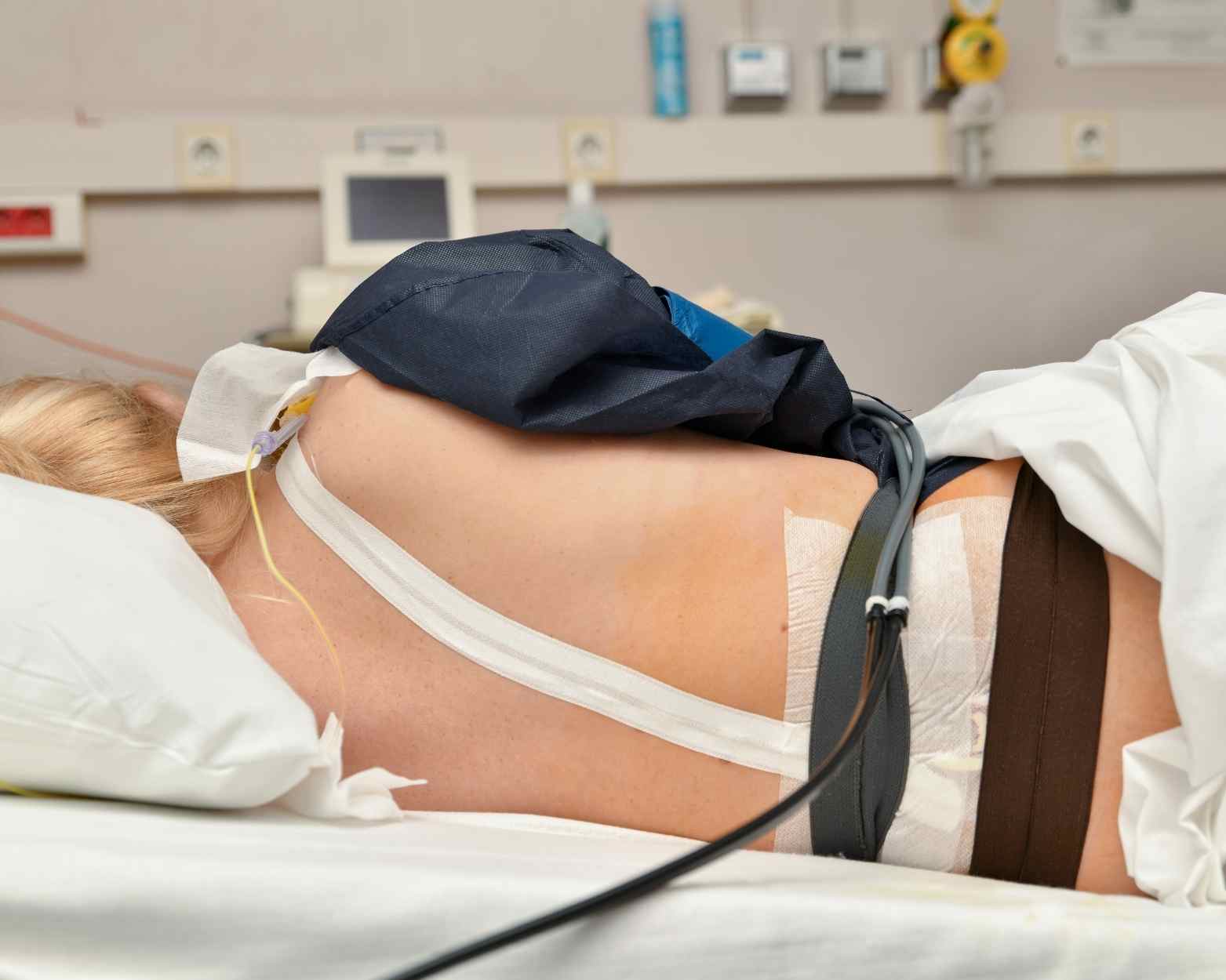Welcome to an exciting journey of labor and childbirth!

As you prepare to bring your baby into the world, one essential aspect to keep in mind is the importance of changing positions during labor.
In this blog post, we’ll explore the numerous benefits of movement and different positions during labor, both for you and your baby. Remember, you have the strength within you to navigate this incredible experience!
Just a heads up, this page may contain Amazon, Etsy, and other affiliate links. We may make a small commission from any clicks at no expense to you. Head over to our disclosure policy for more information.
Benefits of Changing Labor Positions for Mom
When it comes to labor, changing positions can be a game-changer for moms-to-be. Here are some of the benefits you can enjoy by staying active and exploring various positions:
- Promotes labor progress: Movement and position changes help the baby descend through the birth canal, facilitating a smoother and shorter labor.
- Reduces discomfort: Certain positions can provide relief from back pain and pressure, making contractions more manageable.
- Enhances pelvic opening: Positions like squatting, kneeling, or lunging can open up the pelvis, allowing more room for the baby to move through.
- Maximizes relaxation: Experimenting with different positions enables you to find what feels most comfortable and relaxing for you, promoting a calmer state of mind.
- Promotes circulation: Movement and position changes help maintain healthy blood flow, reducing the risk of swelling and enhancing oxygen supply to both you and your baby.
- Reduces the chance of interventions: By actively changing positions, you can optimize your body’s natural ability to birth, potentially reducing or eliminating the need for medical interventions such as a c-section.
- Shortens Labor: Frequent position changes help labor progress more swiftly, reducing the overall duration.
- Provides Sense of Control: Active participation in position changes empowers you, enhancing your confidence and trust in your body’s ability to birth.
- Promotes efficient contractions: Position changes help ensure effective uterine contractions, providing your baby with the necessary stimulation to progress through the birthing process.
[Related post: Unmedicated Labor Coping Techniques]
Benefits of Changing Positions for Baby
Changing positions during labor also benefits your baby!
- Optimal positioning: Movement encourages the baby to align their head with the pelvis, improving the chances of an optimal birthing position.
- Facilitates descent: Different positions utilize the force of gravity, helping the baby move down through the birth canal more easily.
- Enhances blood flow and oxygenation: Position changes improve blood circulation and oxygen supply to the baby, promoting their well-being during labor.
- Encourages an active birth: Changing positions during childbirth helps to create space within the pelvis, allowing your baby to navigate through the birth canal and actively participate in their own birth.
- Facilitates Rotation: Certain positions aid in the rotation of the baby’s head, making it easier for them to navigate the birth canal.
- Reduces Cord Compression: Position changes can alleviate pressure on the umbilical cord, ensuring a continuous supply of oxygen to your baby and less potential issues!
Changing Positions with an Epidural
Contrary to popular belief, you can still change positions even if you’ve opted for an epidural. While movement might be more limited, there are modifications you can explore, such as side-lying, supported sitting or using a birthing ball.
In fact, we wrote an entire post about labor positions with an epidural. Check it out!

Hire a Doula
One incredible resource to consider during your labor journey is the support of a doula. A doula is a trained professional who specializes in providing physical, emotional, and informational support to expectant parents before, during, and after childbirth.
When it comes to changing positions during labor, a doula can be life-changing.
- Suggesting new positions: Doulas are well-versed in a wide range of labor positions and can offer valuable suggestions based on your specific needs and progress. They can guide you in finding positions that align with your comfort and help optimize your labor experience. The positions I’ll cover in this article are wonderful, but having someone in the room who can think of, suggest, and then assist you with getting into new positions every 30 minutes is a game-changer.
- Reminding you to change positions: Amidst the intensity of labor, it’s easy to lose track of time and forget to change positions regularly. Your brain does NOT work like normal during labor… and for a good reason, you are pushing out a brand-new human, after all. A doula will gently remind you to shift positions, ensuring you maintain an active and dynamic approach to labor.
- Providing physical support: Doulas are skilled in providing physical assistance during position changes. They can help you transition between positions, provide comfort measures like massage or counter pressure, and assist with maintaining balance and stability during movement. Many of the labor positions on our list are going to require the physical strength or support of another adult! Especially if you get the epidural.
- Emotional encouragement: Labor can be both physically and emotionally challenging. Doulas are there to offer continuous emotional support, reassuring you and boosting your confidence throughout the process. They create a nurturing and calming environment, which encourages you to explore different positions and embrace your body’s innate ability to give birth.
- Advocacy and communication: Doulas are knowledgeable about various birthing options and can help facilitate communication with your healthcare provider. If you have specific preferences for position changes or concerns about medical interventions, a doula can advocate for your choices and ensure your voice is heard.
Having a doula as part of your birth team is entirely optional, but their company can significantly enhance your entire birthing experience.
Their dedicated support can foster a positive and empowering atmosphere, encouraging you to explore different positions, adapt to your body’s needs, and have an active role in your birthing journey.
[Related post: Positive Birth Affirmations]
They work collaboratively with your healthcare provider to provide continuous support and personalized care, empowering you to navigate the labor process with confidence and comfort.
20 Labor Positions for an Active Labor
Here are 20 labor positions to add to your labor and birth toolbox. You’ll notice none of them have you lying on your back! But as always, listen to your body and choose positions that feel right for you:
- Squatting: A powerful position that widens the pelvic outlet and encourages gravity to assist. Most hospital beds have a railing you can use for a supported squat. You can also ask for help from your birthing partner, doula, or medical team.
- Kneeling: Offers relief from back pain and promotes optimal baby positioning. I spent a large portion of my labor kneeling on the bed – I propped it up to roughly a 105-degree angle and kneeled on it backward with my arms hanging over the back. This was also a great position for my birth team to use the rebozo during contractions properly.
- Lunging: Helps create space in the pelvis while maintaining balance and stability. This labor position requires some strength! But you can always do a modified lunge on the bed.
- Standing and swaying: Promotes movement and provides comfort during contractions. In our Bradley method class, we practiced this position with some soft music and were told to pretend we were slow dancing.
- All fours: Relieves back pain and encourages the baby’s rotation into an ideal position. Your arms may get tired after some time, so consider stacking up some pillows to rest your upper body on.
- Side-lying: A resting position that allows you to conserve energy and rest between contractions. Throw a peanut ball between your legs to make this position more effective!
- Supported sitting: Sitting on a birthing ball or with cushions for added comfort and stability. One amazing place to do this is the toilet! Yes. The toilet. Sit backward on the toilet and put a pillow over the water tank to rest your head on.
- Leaning forward: Stand and rest your upper body on a surface, such as a bed or a chair, to help alleviate pressure.
- Rocking: Gentle swaying or rocking motions to ease discomfort and encourage relaxation. Rocking in labor can be done in a standing or seated position.
- Rebozo sifting: THIS. Using a long, woven scarf, you can apply pressure or gentle pelvic rocking to relieve pain. My poor birth team must have also been exhausted from how much rebozo work I had them doing during my labor.
- Birthing stool: There are some really cool inflatable birthing stools that you can labor and deliver in! They help you stay in a seated position to open up the pelvis and facilitate the baby’s descent.
- Supported squat: Squatting while leaning against a wall or using a partner for support.
- Reclining: Lying on your side or back with elevated hips to encourage the baby’s descent. This one is great if you need some time to rest or recover, just don’t stay in this position too long!
- Walking: Taking short walks during early labor to encourage contractions and progress.
- Birth ball bouncing: Sitting on a birthing ball and gently bouncing to relieve pressure and encourage engagement.
- Butterfly pose: Seated with the soles of your feet together and knees out to the sides, supporting pelvic opening.
- Water immersion: Laboring in a birthing pool or bathtub can offer buoyancy and relieve pressure. Also, consider a nice hot shower – sometimes the hot water can help alleviate back labor pains.
- Wedge: Reclining with a wedge under one hip is a great way to rest without being on your back.
- Supported standing with one foot on a step or stool: creating an uneven angle in your pelvis helps the baby move down! Just remember to spend an equal amount of time on each side.
- Repeating positions: Rotating through different positions at regular intervals to maximize benefits.
- Knees together, feet apart: As your baby moves down into your pelvis, you will find that keeping your knees together and your feet apart actually creates the most space in your pelvis for the baby’s head.
Embracing movement and changing birthing positions during labor can have profound effects on your birthing experience.
In short, labor position changes will:
- Promote progress
- Increase comfort
- Shorten labor
- Reduce interventions
- Empower and inspire
- Benefit baby
From promoting progress and comfort to benefiting both you and your baby, the power of movement is a valuable tool. Stay open to exploring different childbirth positions, consider the guidance of a doula, and trust in your body’s innate wisdom.
Remember, you are capable, strong, and ready to welcome your little one into the world in the most empowering way possible.
Your body is not only capable but specifically designed to birth your baby.
Best wishes for a beautiful and transformative birth experience.
You got this, mama.
Jess


